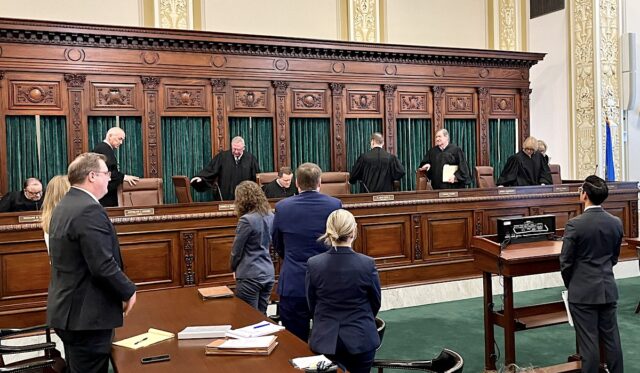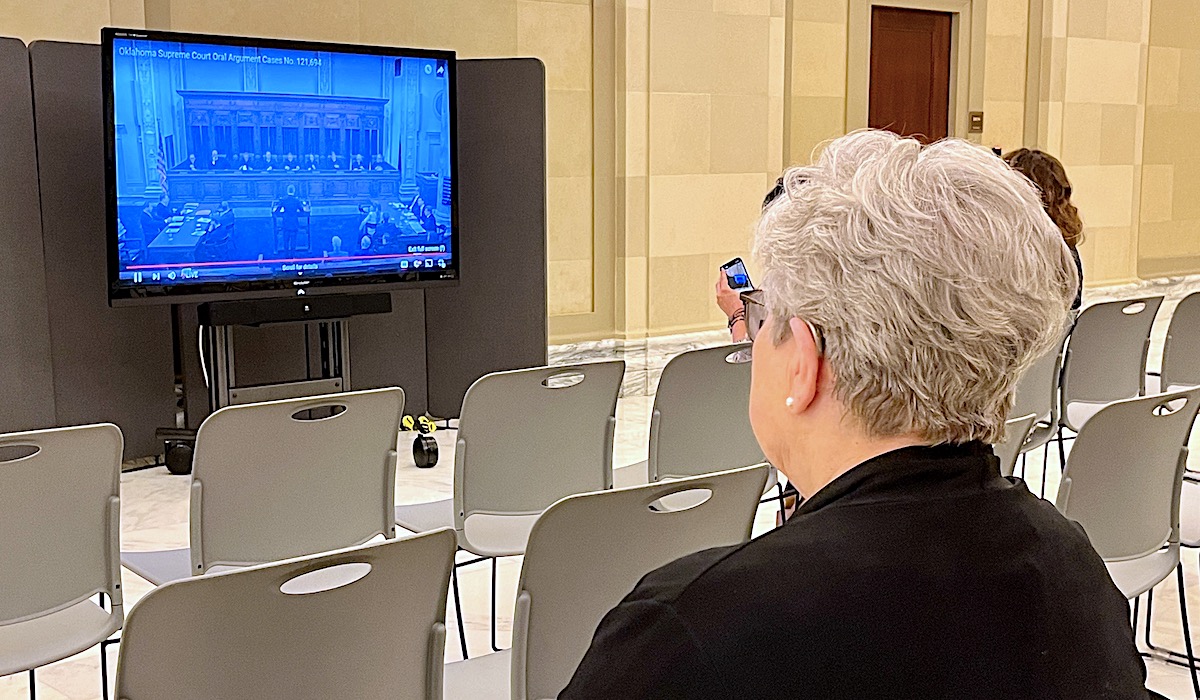
As state leaders await a bevy of pending state Supreme Court decisions and watch for potential resurrection of a controversial attempt to reform how judges are nominated, the Oklahoma Legislature has another pair of major court decisions left on its docket this session: whether to create a new judicial evaluation program that stalled last year and whether to authorize a proposed pay raise for those on the bench.
In September, the Board on Judicial Compensation held its biennial meeting and recommended a 17 percent raise for all appellate and district court judges in Oklahoma. Under state law, that recommendation presents the Legislature with three options: take no action and have the full recommendation take effect; pass legislation to raise judicial pay by a different amount; pass legislation rejecting the recommended raise entirely.
In 2022, the Legislature took no action and allowed a recommended 7.67 percent pay raise for all judges take effect. In 2020, the Legislature cut a recommended 9 percent judicial pay raise in half and approved a 4.5 percent hike.
But this year, a lingering legislative proposal from last year has been intermingled with the pay raise question.
For the past three sessions, House Appropriations and Budget Chairman Kevin Wallace (R-Wellston) has pushed to create a judicial evaluation program — a way for attorneys and parties to provide private feedback about judicial performance, and a way for judges to receive additional training, education and guidance after being appointed to or elected to the bench.
Last year, the House sent the Senate Wallace’s HB 2850 on a 78-8 vote. Then, the Senate Judiciary Committee advanced it unanimously, but it did not receive a Senate floor hearing. During a budget-related concurrent special session, the chambers revealed the proposal again as HB 1022XX, which narrowly passed 51-45 in the House but failed 15-29 in the Senate. Despite the bill’s Senate failure, new funding for judicial education programs was sent to the Administrative Office of the Courts.
This year, Wallace is supporting a version that was revised by the Supreme Court’s chief justice, and Wallace has said he wants it passed before the Legislature agrees to any sort of judicial pay raise.
“In my budget, there is no money for funding judicial pay,” Wallace told NonDoc on March 28. “If we can’t do an evaluation, I don’t see how you continue to give employees pay increases. So I’m pretty firm.”
One week later, Jari Askins, the administrative director of the courts, delivered Wallace and Senate President Pro Tempore Greg Treat (R-OKC) a revised version of a judicial evaluation program that she said Chief Justice M. John Kane IV had helped edit. One week after that, Treat said April 11 he was still reviewing the modified proposal.
“I’ve talked to the Supreme Court as well on that and am trying to see if there’s something workable on that because they will have to administer it,” Treat said. “Overall, having more information on the people who make decisions is not a bad thing. I’ve just got to make sure it’s workable.”
But nearly two weeks later, Wallace noted that the deadline to modify HB 2850 as assigned in the Senate has technically passed, and he expressed concern that the new language supported by the Administrative Office of the Court has not been filed as an amendment to any other bill.
“Somebody told me they were going to move bills direct to calendar, but this is deadline week as well for some bills,” Wallace said Monday. “Here’s the problem. The amended language, which would have been a committee [substitute] or a floor [substitute], has not been made public. So you’re not going to get judges to give support for something they’ve never seen.”
‘Hopefully the judges aren’t outfoxing the Legislature again’

Amid inter-chamber competition over whose budget negotiation processes are more transparent, Wallace provided NonDoc with a copy of the new judicial evaluation proposal presented to the House and Senate by Askins. That drafted version (embedded below) would direct the Oklahoma Supreme Court to create the Office of Judicial Performance Evaluation within the Administrative Office of the Courts and create the Judicial Performance Evaluation Council “to administer the process for reviewing the performance of judicial officers” under rules created by the Supreme Court.
RELATED
Board recommends 17% judicial pay raise to Legislature by Michael McNutt
“The purposes of the judicial evaluation process are to provide information on judicial performance for the citizens of Oklahoma and to judges; assist judges with opportunities for improving judicial performance; identify needed judicial education programs; and promote goals of protecting judicial independence while fostering public accountability of the judiciary,” according to the introductory section of the proposed bill.
Askins told NonDoc that the revised proposal addresses “separation of powers concerns” that existed in Wallace’s 2023 version, although the language drafted below may not be identical to whatever substitute the Senate may decide to hear.
“The chief justice worked on some language — had me work on some language — following the example of other states where the evaluation process was under the Supreme Court, and under the Administrative Office of the Courts, not under an executive branch entity,” Askins said. “Rep. Wallace signed off on the language about four weeks ago and had me take a copy of it to his Senate author. So we’re hoping that if anything moves on it, that it will be this new language.”
The Senate author of Wallace’s proposal has been Sen. Brent Howard (R-Altus), who said Monday that he “would like to” move the bill forward. However, he said he needed to check with Treat on the status of the proposal.
“I know there has been more talk and discussion, but right now it’s going to more of just finding the (legislative) vehicles that are available for it,” Howard said.
With the Senate’s budget spreadsheets showing a proposed 6 percent pay raise for district court and appellate court judges and the House’s spreadsheets showing zero, Howard acknowledged that Wallace has tied the evaluation proposal to the pay raise question.
“I know there has been consideration as to one bill being the matter of whether those increases or any increases go into effect,” Howard said. “My consideration is that if no action is taken, the recommendation of the Judicial Compensation Board will go into effect, and that’s a full 17 percent (raise).”
Wallace agreed Monday that the potential stalemate over judicial evaluation could result in the full pay raise recommendation taking effect if the House and Senate do not agree on an alternative.
“We either have to do something — reject or amend — or it goes into effect July 1,” Wallace said. “Hopefully the judges aren’t outfoxing the Legislature again.”
Askins said it’s possible the revised language negotiated with Kane could break the stalemate.
“The new language is following what other states have. It’s much shorter language than the old bill the last few years has been. And this is language that would say the Supreme Court shall establish rules to develop a certain process, the states that we looked at typically have used a vendor to do surveys, and compile those surveys outside of the court’s office staff,” Askins said. “To me, that just increases the independence of what that evaluation is. So the whole key was for the Supreme Court then to receive those evaluations, determine which judges might need individual improvement plans, and give them a program to improve their performance evaluation.”
According to the Institute for the Advancement of the American Legal System at the University of Denver, at least 17 states have some sort of judicial evaluation program. According to its website, the IAALS is an independent research organization “that innovates and advances solutions that make our civil justice system more just.”
House Speaker Charles McCall (R-Atoka) said Tuesday he understands arguments on all sides of the questions.
“In the private sector, pay raises just don’t happen just because somebody in your same industry says, ‘This is the average,'” McCall said. “But I also understand that a regional average for the judicial branch drives a lot of whether or not a practicing attorney could ever consider leaving (their practice) to join the judiciary.”
McCall said Wallace “has a lot of good points in terms of the approach of his bill.”
In recent years, at least two district court judges — Kendra Coleman in Oklahoma County and Traci Soderstrom in Lincoln County — have faced removal actions from the Court on the Judiciary. Former Oklahoma County Judge Tim Henderson also resigned following allegations of sexual misconduct. Other judicial actions have also made headlines.
RELATED
Roundup: SJR 34 failed despite McCall email, OSDE rules questioned, Slavonic to leave ODVA by NonDoc staff members
When discussing his desire for the evaluation proposal, Wallace has made subtle reference to some of those cases. Soderstrom, for instance, held a district court judgeship within Wallace’s district.
“It’s not an ‘I-got-you’ bill. It’s nothing like that,” Wallace said at the start of session. “It’s just trying to improve the judicial system and making sure that the judges get the resources and training they need.”
McCall said Wallace must “sell the Senate” on his idea, which failed last year in its prior form.
“I think every branch of government should have it in some segment. The executive branch would have it within the agencies, the elected (officials) here in the Legislature — I mean, we get a report card every two years. The people that work for the House full time that are non-elected, they go through annual evaluations by department supervisors who make recommendations on pay raises and whatnot,” McCall said. “The judiciary is a different branch of government, which is why I think it is smart and wise of Kevin Wallace to work through that over the last three years with the judiciary to find a functional model that works for them.”
Asked his thoughts on the judicial pay raise and evaluation proposals, Gov. Kevin Stitt said Tuesday that he is open to both concepts.
“A 17 percent pay increase just one time seems like a whole bunch, so I don’t know exactly what the justification is,” Stitt said. “I believe you need to pay market, so there’s probably some district judges that are under market, so we need to make sure we can pay them what they’re making in Arkansas and what they’re making in other states. The Legislature is going to have to decide on that, so that’s up to them.”
Stitt said he would like to know more about how quickly judges are adjudicating cases in Oklahoma.
“The judicial branch, kind of on their own, there’s no accountability on what’s their work load, how quickly they can do it,” Stitt said. “So there needs to be a little bit of accountability that that office has. How you set that up, I don’t know. But I think Oklahomans would like to see some kind of workload report and how quickly they decide on cases, etc. etc.”
‘How lucky I have been’: Jari Askins set to retire in June

As Askins watches legislative leaders mull over the judicial pay and judicial evaluation proposals, she knows the two questions could be among the final policy proposals navigated through the process with her guidance.
A former Democratic lieutenant governor and former minority leader in the Oklahoma House, Askins announced her impending retirement from the Administrative Office of the Courts late Friday.
“How lucky I have been to serve these 8.5+ years in a role that requires every bit of experience I gained throughout my public service life. What a blessing to work with the best team of dedicated coworkers in service to Oklahoma’s judicial branch,” Askins wrote in an email to all state judges. “I love coming to work Every. Single. Day. That’s why it will be hard to say goodbye at the end of June.”
House Civil Judiciary Committee Chairman Chris Kannady (R-OKC) praised Askins on Monday.
“I support her and wish her well in whatever her endeavors may be. With that said, I think people need to recognize the service she has done her entire life for this state,” Kannady said. “She’s a friend, she’s a mentor of mine, and she will be missed in these halls. I hope she won’t be a stranger.”
While Kannady declined to offer his thoughts on the pending judicial pay and judicial evaluation questions, Askins hinted at the lingering proposals at the conclusion of her email.
“I know I am not yet finished ‘being busy’ but I look forward to shorter time commitments,” Askins wrote. “Until then, buckle up. We still have a lot of work to do!”






















